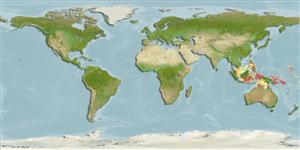Teleostei (teleosts) >
Eupercaria/misc (Various families in series Eupercaria) >
Malacanthidae (Tilefishes)
Etymology: Hoplolatilus: Greek, hoplon = weapon + Latin, latus = wide (Ref. 45335).
Eponymy: John Frederick Pohle (1935–2016) was a US Airforce officer and research scuba diver. [...] (Ref. 128868), visit book page.
Environment: milieu / climate zone / depth range / distribution range
Ecology
Marine; reef-associated; depth range 40 - 90 m (Ref. 32518). Tropical
Western Pacific: Indonesia and Papua New Guinea.
Size / Weight / Age
Maturity: Lm ? range ? - ? cm
Max length : 11.0 cm SL (female)
Short description
Identification keys | Morphology | Morphometrics
Pairs hovering within a meter above the bottom were observed. Sometimes solitary (Ref 90102).
Life cycle and mating behavior
Maturity | Reproduction | Spawning | Eggs | Fecundity | Larvae
Displays obligate monogamy where a one-to-one pair is established irrespective of resource abundance (Ref. 52884).
Earle, J.L. and R. Pyle, 1997. Hoplolatilus pohle, a new species of sand tilefish (Perciformes: Malacanthidae) from the deep reefs of the D'Entrecasteaux Islands, Papua New Guinea. Copeia 1997(2):382-387. (Ref. 32518)
IUCN Red List Status (Ref. 130435: Version 2024-1)
Threat to humans
Harmless
Human uses
Tools
Special reports
Download XML
Internet sources
Estimates based on models
Preferred temperature (Ref.
123201): 26.8 - 28.7, mean 27.4 °C (based on 75 cells).
Phylogenetic diversity index (Ref.
82804): PD
50 = 0.5001 [Uniqueness, from 0.5 = low to 2.0 = high].
Bayesian length-weight: a=0.01122 (0.00514 - 0.02450), b=3.04 (2.87 - 3.21), in cm total length, based on all LWR estimates for this body shape (Ref.
93245).
Trophic level (Ref.
69278): 3.4 ±0.4 se; based on size and trophs of closest relatives
Fishing Vulnerability (Ref.
59153): Low vulnerability (10 of 100).
